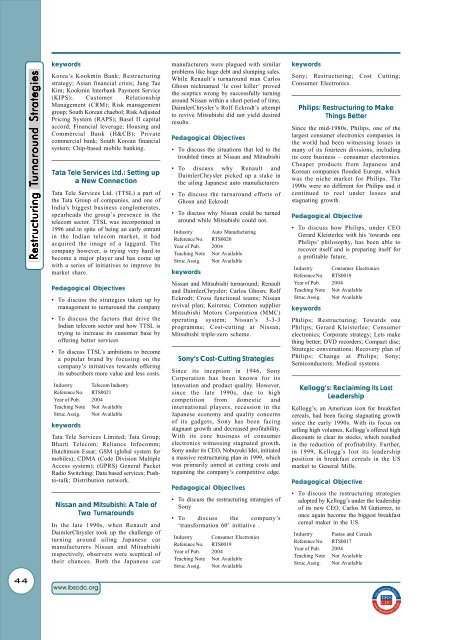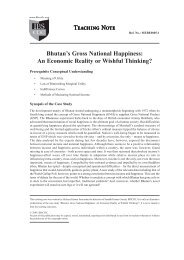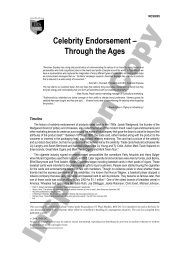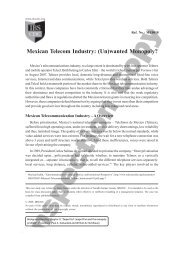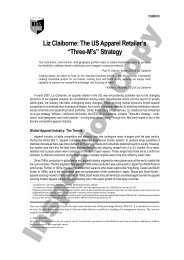List of Case Studies on Strategy - Case Catalogue IV
List of Case Studies on Strategy - Case Catalogue IV
List of Case Studies on Strategy - Case Catalogue IV
You also want an ePaper? Increase the reach of your titles
YUMPU automatically turns print PDFs into web optimized ePapers that Google loves.
44<br />
Restructuring estructuring T TTurnaround<br />
T urnaround Strategies<br />
Strategies<br />
keywords<br />
Korea’s Kookmin Bank; Restructuring<br />
strategy; Asian financial crisis; Jung Tae<br />
Kim; Kookmin Interbank Payment Service<br />
(KIPS); Customer Relati<strong>on</strong>ship<br />
Management (CRM); Risk management<br />
group; South Korean chaebol; Risk Adjusted<br />
Pricing System (RAPS); Basel II capital<br />
accord; Financial leverage; Housing and<br />
Commercial Bank (H&CB); Private<br />
commercial bank; South Korean financial<br />
system; Chip-based mobile banking.<br />
Tata Tele Services Ltd.: Setting up<br />
a New C<strong>on</strong>necti<strong>on</strong><br />
Tata Tele Services Ltd. (TTSL) a part <str<strong>on</strong>g>of</str<strong>on</strong>g><br />
the Tata Group <str<strong>on</strong>g>of</str<strong>on</strong>g> companies, and <strong>on</strong>e <str<strong>on</strong>g>of</str<strong>on</strong>g><br />
India's biggest business c<strong>on</strong>glomerates,<br />
spearheads the group’s presence in the<br />
telecom sector. TTSL was incorporated in<br />
1996 and in spite <str<strong>on</strong>g>of</str<strong>on</strong>g> being an early entrant<br />
in the Indian telecom market, it had<br />
acquired the image <str<strong>on</strong>g>of</str<strong>on</strong>g> a laggard. The<br />
company however, is trying very hard to<br />
become a major player and has come up<br />
with a series <str<strong>on</strong>g>of</str<strong>on</strong>g> initiatives to improve its<br />
market share.<br />
Pedagogical Objectives<br />
• To discuss the strategies taken up by<br />
management to turnaround the company<br />
• To discuss the factors that drive the<br />
Indian telecom sector and how TTSL is<br />
trying to increase its customer base by<br />
<str<strong>on</strong>g>of</str<strong>on</strong>g>fering better services<br />
• To discuss TTSL’s ambiti<strong>on</strong>s to become<br />
a popular brand by focusing <strong>on</strong> the<br />
company’s initiatives towards <str<strong>on</strong>g>of</str<strong>on</strong>g>fering<br />
its subscribers more value and less costs.<br />
Industry Telecom Industry<br />
Reference No. RTS0021<br />
Year <str<strong>on</strong>g>of</str<strong>on</strong>g> Pub. 2004<br />
Teaching Note Not Available<br />
Struc.Assig. Not Available<br />
keywords<br />
Tata Tele Services Limited; Tata Group;<br />
Bharti Telecom; Reliance Infocomm;<br />
Hutchins<strong>on</strong> Essar; GSM (global system for<br />
mobiles); CDMA (Code Divisi<strong>on</strong> Multiple<br />
Access system); (GPRS) General Packet<br />
Radio Switching; Data based services; Pushto-talk;<br />
Distributi<strong>on</strong> network.<br />
Nissan and Mitsubishi: A Tale <str<strong>on</strong>g>of</str<strong>on</strong>g><br />
Two Turnarounds<br />
In the late 1990s, when Renault and<br />
DaimlerChrysler took up the challenge <str<strong>on</strong>g>of</str<strong>on</strong>g><br />
turning around ailing Japanese car<br />
manufacturers Nissan and Mitsubishi<br />
respectively, observers were sceptical <str<strong>on</strong>g>of</str<strong>on</strong>g><br />
their chances. Both the Japanese car<br />
www.ibscdc.org<br />
manufacturers were plagued with similar<br />
problems like huge debt and slumping sales.<br />
While Renault’s turnaround man Carlos<br />
Ghosn nicknamed ‘le cost killer’ proved<br />
the sceptics wr<strong>on</strong>g by successfully turning<br />
around Nissan within a short period <str<strong>on</strong>g>of</str<strong>on</strong>g> time,<br />
DaimlerChrysler’s Rolf Eckrodt’s attempt<br />
to revive Mitsubishi did not yield desired<br />
results.<br />
Pedagogical Objectives<br />
• To discuss the situati<strong>on</strong>s that led to the<br />
troubled times at Nissan and Mitsubishi<br />
• To discuss why Renault and<br />
DaimlerChrysler picked up a stake in<br />
the ailing Japanese auto manufacturers<br />
• To discuss the turnaround efforts <str<strong>on</strong>g>of</str<strong>on</strong>g><br />
Ghosn and Eckrodt<br />
• To discuss why Nissan could be turned<br />
around while Mitsubishi could not.<br />
Industry Auto Manufacturing<br />
Reference No. RTS0020<br />
Year <str<strong>on</strong>g>of</str<strong>on</strong>g> Pub. 2004<br />
Teaching Note Not Available<br />
Struc.Assig. Not Available<br />
keywords<br />
Nissan and Mitsubishi turnaround; Renault<br />
and DaimlerChrysler; Carlos Ghosn; Rolf<br />
Eckrodt; Cross functi<strong>on</strong>al teams; Nissan<br />
revival plan; Keiretsu; Comm<strong>on</strong> supplier<br />
Mitsubishi Motors Corporati<strong>on</strong> (MMC)<br />
operating system; Nissan’s 3-3-3<br />
programme; Cost-cutting at Nissan;<br />
Mitsubishi triple-zero scheme.<br />
S<strong>on</strong>y’s Cost-Cutting Strategies<br />
Since its incepti<strong>on</strong> in 1946, S<strong>on</strong>y<br />
Corporati<strong>on</strong> has been known for its<br />
innovati<strong>on</strong> and product quality. However,<br />
since the late 1990s, due to high<br />
competiti<strong>on</strong> from domestic and<br />
internati<strong>on</strong>al players, recessi<strong>on</strong> in the<br />
Japanese ec<strong>on</strong>omy and quality c<strong>on</strong>cerns<br />
<str<strong>on</strong>g>of</str<strong>on</strong>g> its gadgets, S<strong>on</strong>y has been facing<br />
stagnant growth and decreased pr<str<strong>on</strong>g>of</str<strong>on</strong>g>itability.<br />
With its core business <str<strong>on</strong>g>of</str<strong>on</strong>g> c<strong>on</strong>sumer<br />
electr<strong>on</strong>ics witnessing stagnated growth,<br />
S<strong>on</strong>y under its CEO, Nobuyuki Idei, initiated<br />
a massive restructuring plan in 1999, which<br />
was primarily aimed at cutting costs and<br />
regaining the company’s competitive edge.<br />
Pedagogical Objectives<br />
• To discuss the restructuring strategies <str<strong>on</strong>g>of</str<strong>on</strong>g><br />
S<strong>on</strong>y<br />
• To discuss the company’s<br />
‘transformati<strong>on</strong> 60’ initiative .<br />
Industry C<strong>on</strong>sumer Electr<strong>on</strong>ics<br />
Reference No. RTS0019<br />
Year <str<strong>on</strong>g>of</str<strong>on</strong>g> Pub. 2004<br />
Teaching Note Not Available<br />
Struc.Assig. Not Available<br />
keywords<br />
S<strong>on</strong>y; Restructuring; Cost Cutting;<br />
C<strong>on</strong>sumer Electr<strong>on</strong>ics.<br />
Philips: Restructuring to Make<br />
Things Better<br />
Since the mid-1980s, Philips, <strong>on</strong>e <str<strong>on</strong>g>of</str<strong>on</strong>g> the<br />
largest c<strong>on</strong>sumer electr<strong>on</strong>ics companies in<br />
the world had been witnessing losses in<br />
many <str<strong>on</strong>g>of</str<strong>on</strong>g> its fourteen divisi<strong>on</strong>s, including<br />
its core business – c<strong>on</strong>sumer electr<strong>on</strong>ics.<br />
Cheaper products from Japanese and<br />
Korean companies flooded Europe, which<br />
was the niche market for Philips. The<br />
1990s were no different for Philips and it<br />
c<strong>on</strong>tinued to reel under losses and<br />
stagnating growth.<br />
Pedagogical Objective<br />
• To discuss how Philips, under CEO<br />
Gerard Kleisterlee with his ‘towards <strong>on</strong>e<br />
Philips’ philosophy, has been able to<br />
recover itself and is preparing itself for<br />
a pr<str<strong>on</strong>g>of</str<strong>on</strong>g>itable future.<br />
Industry C<strong>on</strong>sumer Electr<strong>on</strong>ics<br />
Reference No. RTS0018<br />
Year <str<strong>on</strong>g>of</str<strong>on</strong>g> Pub. 2004<br />
Teaching Note Not Available<br />
Struc.Assig. Not Available<br />
keywords<br />
Philips; Restructuring; Towards <strong>on</strong>e<br />
Philips; Gerard Kleisterlee; C<strong>on</strong>sumer<br />
electr<strong>on</strong>ics; Corporate strategy; Lets make<br />
thing better; DVD recorders; Compact disc;<br />
Strategic c<strong>on</strong>versati<strong>on</strong>s; Recovery plan <str<strong>on</strong>g>of</str<strong>on</strong>g><br />
Philips; Change at Philips; S<strong>on</strong>y;<br />
Semic<strong>on</strong>ductors; Medical systems.<br />
Kellogg’s: Reclaiming its Lost<br />
Leadership<br />
Kellogg’s, an American ic<strong>on</strong> for breakfast<br />
cereals, had been facing stagnating growth<br />
since the early 1990s. With its focus <strong>on</strong><br />
selling high volumes, Kellogg’s <str<strong>on</strong>g>of</str<strong>on</strong>g>fered high<br />
discounts to clear its stocks, which resulted<br />
in the reducti<strong>on</strong> <str<strong>on</strong>g>of</str<strong>on</strong>g> pr<str<strong>on</strong>g>of</str<strong>on</strong>g>itability. Further,<br />
in 1999, Kellogg’s lost its leadership<br />
positi<strong>on</strong> in breakfast cereals in the US<br />
market to General Mills.<br />
Pedagogical Objective<br />
• To discuss the restructuring strategies<br />
adopted by Kellogg’s under the leadership<br />
<str<strong>on</strong>g>of</str<strong>on</strong>g> its new CEO, Carlos M Gutierrez, to<br />
<strong>on</strong>ce again become the biggest breakfast<br />
cereal maker in the US.<br />
Industry Pastas and Cereals<br />
Reference No. RTS0017<br />
Year <str<strong>on</strong>g>of</str<strong>on</strong>g> Pub. 2004<br />
Teaching Note Not Available<br />
Struc.Assig. Not Available


